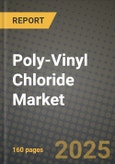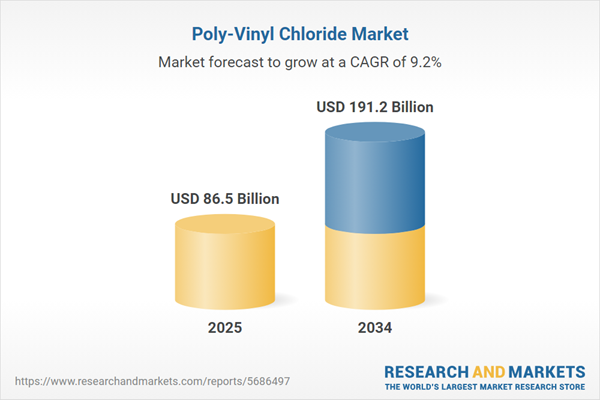The global polyvinyl chloride (PVC) market continues to expand, driven by its widespread applications across industries such as construction, automotive, healthcare, and packaging. PVC is one of the most versatile and cost-effective thermoplastics, offering excellent durability, chemical resistance, and ease of processing. The construction sector remains the dominant consumer, utilizing PVC in pipes, fittings, windows, flooring, and roofing materials due to its strength and weather resistance. In addition, the growing demand for lightweight and durable materials in automotive manufacturing has fueled the adoption of PVC for interior trims, dashboards, and wire insulation. The healthcare industry also relies on medical-grade PVC for tubing, blood bags, and IV containers, given its biocompatibility and sterilization capabilities. However, increasing environmental concerns regarding PVC’s impact and the regulatory push for sustainable alternatives are shaping industry strategies, with manufacturers focusing on bio-based and recyclable PVC solutions.
The PVC market saw significant advancements in both production technology and sustainability efforts. Manufacturers increasingly adopted energy-efficient production processes to reduce emissions and comply with stricter environmental regulations. The push for green construction accelerated the demand for low-emission and lead-free PVC materials, particularly in developed markets. Additionally, the recycling of post-consumer and post-industrial PVC gained momentum, with companies investing in closed-loop recycling technologies to minimize plastic waste. The Asia-Pacific region remained a key driver of market growth, with infrastructure projects in China, India, and Southeast Asia significantly boosting demand. The automotive industry also experienced rising PVC consumption, particularly in electric vehicles (EVs), where lightweight materials help improve energy efficiency. Meanwhile, regulatory bodies imposed stricter restrictions on phthalate plasticizers in flexible PVC applications, prompting manufacturers to explore safer, non-toxic alternatives.
The PVC market is expected to witness further technological innovations, sustainability-driven reforms, and shifting demand dynamics. Advances in bio-based PVC production will gain traction as companies seek to align with circular economy goals and reduce dependency on fossil-fuel-based polymers. Additionally, smart manufacturing processes integrating automation and AI-driven quality control will enhance efficiency and reduce waste in PVC production. The demand for PVC in infrastructure projects will remain strong, particularly in emerging economies where urbanization is accelerating. In the medical sector, the development of phthalate-free, antimicrobial PVC materials will address safety concerns while expanding market applications. Moreover, geopolitical factors and trade policies will influence supply chain dynamics, with regional players focusing on localized production to mitigate disruptions. As regulatory scrutiny increases, the industry will see a shift toward sustainable additives and non-toxic stabilizers, ensuring compliance with evolving environmental standards.
Key Insights: Poly-Vinyl Chloride Market
- Rise of Bio-Based and Recyclable PVC: Manufacturers are investing in bio-based PVC formulations and closed-loop recycling systems to reduce environmental impact and meet regulatory requirements for sustainable plastic solutions.
- Increased Adoption in Electric Vehicles (EVs): Lightweight and durable PVC materials are being widely used in EV components, including insulation for high-voltage cables, interior trims, and weatherproof coatings, enhancing vehicle efficiency.
- Advancements in Smart Manufacturing: The integration of automation, AI-driven process monitoring, and digital twins in PVC production is improving efficiency, reducing energy consumption, and minimizing material waste.
- Stricter Regulations on Plasticizers: Regulatory authorities are imposing tighter restrictions on hazardous plasticizers in flexible PVC applications, prompting the development of safer, phthalate-free alternatives.
- Expansion of Green Construction Initiatives: The growing emphasis on eco-friendly building materials is driving demand for low-emission, non-toxic PVC products, particularly in developed markets with stringent environmental policies.
- Growing Infrastructure and Urbanization: Rapid urbanization and large-scale infrastructure projects in emerging economies are fueling demand for PVC pipes, fittings, flooring, and window profiles in the construction sector.
- Rising Demand in the Healthcare Sector: The increasing use of medical-grade PVC in blood bags, IV tubes, and pharmaceutical packaging is driving market growth due to its sterility, durability, and cost-effectiveness.
- Cost-Effectiveness and Versatility: PVC’s affordability, durability, and ease of processing make it a preferred choice across multiple industries, ensuring its sustained demand in applications ranging from packaging to automotive components.
- Advancements in PVC Recycling Technologies: Ongoing improvements in mechanical and chemical recycling processes are enabling the industry to recover and reuse PVC waste, addressing environmental concerns and regulatory pressures.
- Environmental and Regulatory Concerns: The growing scrutiny over PVC’s environmental impact, including concerns over plastic waste and toxic additives, is leading to stricter regulations and increasing pressure on manufacturers to develop greener alternatives.
Poly-Vinyl Chloride Market Segmentation
By Product Type
- Rigid PVC
- Flexible PVC
- Low-smoke PVC
- Chlorinated PVC
By Application
- Pipes & Fittings
- Film & Sheets
- Wire & Cables
- Bottles
- Profiles
- Hoses & Tubing
- Other Applications
By End User Industry
- Building & Construction
- Automotive
- Electrical & Electronics
- Packaging
- Footwear
- Healthcare
- Other End Use Industries
Key Companies Analysed
- Westlake Chemical Corporation
- Shin-Etsu Chemical Co. Ltd.
- Ineos Group Limited
- Formosa Plastics Corporation
- Occidental Chemical Corporation
- China National Chemical Corporation
- Orbia Advance Corporation SAB de CV
- Axiall Corporation
- BASF SE
- Mitsubishi Chemical Corporation
- DuPont de Nemours Inc.
- LG Chem Ltd.
- Oxy Vinyls LP
- Inovyn ChlorVinyls Limited
- KEM ONE
- Vinnolit GmbH & Co. KG
- Kaneka Corporation
- Hanwha Solutions Corporation
- Teknor Color Company
- Aurora Plastics LLC
- Teknor Apex Company
- Sylvin Technologies Inc.
- Benvic Europe SAS
- Mexichem Specialty Compounds
- Inc.
- Roscom Inc.
Poly-Vinyl Chloride Market Analytics
The report employs rigorous tools, including Porter’s Five Forces, value chain mapping, and scenario-based modeling, to assess supply-demand dynamics. Cross-sector influences from parent, derived, and substitute markets are evaluated to identify risks and opportunities. Trade and pricing analytics provide an up-to-date view of international flows, including leading exporters, importers, and regional price trends.Macroeconomic indicators, policy frameworks such as carbon pricing and energy security strategies, and evolving consumer behavior are considered in forecasting scenarios. Recent deal flows, partnerships, and technology innovations are incorporated to assess their impact on future market performance.
Poly-Vinyl Chloride Market Competitive Intelligence
The competitive landscape is mapped through proprietary frameworks, profiling leading companies with details on business models, product portfolios, financial performance, and strategic initiatives. Key developments such as mergers & acquisitions, technology collaborations, investment inflows, and regional expansions are analyzed for their competitive impact. The report also identifies emerging players and innovative startups contributing to market disruption.Regional insights highlight the most promising investment destinations, regulatory landscapes, and evolving partnerships across energy and industrial corridors.
Countries Covered
- North America - Poly-Vinyl Chloride market data and outlook to 2034
- United States
- Canada
- Mexico
- Europe - Poly-Vinyl Chloride market data and outlook to 2034
- Germany
- United Kingdom
- France
- Italy
- Spain
- BeNeLux
- Russia
- Sweden
- Asia-Pacific - Poly-Vinyl Chloride market data and outlook to 2034
- China
- Japan
- India
- South Korea
- Australia
- Indonesia
- Malaysia
- Vietnam
- Middle East and Africa - Poly-Vinyl Chloride market data and outlook to 2034
- Saudi Arabia
- South Africa
- Iran
- UAE
- Egypt
- South and Central America - Poly-Vinyl Chloride market data and outlook to 2034
- Brazil
- Argentina
- Chile
- Peru
Research Methodology
This study combines primary inputs from industry experts across the Poly-Vinyl Chloride value chain with secondary data from associations, government publications, trade databases, and company disclosures. Proprietary modeling techniques, including data triangulation, statistical correlation, and scenario planning, are applied to deliver reliable market sizing and forecasting.Key Questions Addressed
- What is the current and forecast market size of the Poly-Vinyl Chloride industry at global, regional, and country levels?
- Which types, applications, and technologies present the highest growth potential?
- How are supply chains adapting to geopolitical and economic shocks?
- What role do policy frameworks, trade flows, and sustainability targets play in shaping demand?
- Who are the leading players, and how are their strategies evolving in the face of global uncertainty?
- Which regional “hotspots” and customer segments will outpace the market, and what go-to-market and partnership models best support entry and expansion?
- Where are the most investable opportunities - across technology roadmaps, sustainability-linked innovation, and M&A - and what is the best segment to invest over the next 3-5 years?
Your Key Takeaways from the Poly-Vinyl Chloride Market Report
- Global Poly-Vinyl Chloride market size and growth projections (CAGR), 2024-2034
- Impact of Russia-Ukraine, Israel-Palestine, and Hamas conflicts on Poly-Vinyl Chloride trade, costs, and supply chains
- Poly-Vinyl Chloride market size, share, and outlook across 5 regions and 27 countries, 2023-2034
- Poly-Vinyl Chloride market size, CAGR, and market share of key products, applications, and end-user verticals, 2023-2034
- Short- and long-term Poly-Vinyl Chloride market trends, drivers, restraints, and opportunities
- Porter’s Five Forces analysis, technological developments, and Poly-Vinyl Chloride supply chain analysis
- Poly-Vinyl Chloride trade analysis, Poly-Vinyl Chloride market price analysis, and Poly-Vinyl Chloride supply/demand dynamics
- Profiles of 5 leading companies - overview, key strategies, financials, and products
- Latest Poly-Vinyl Chloride market news and developments
Additional Support
With the purchase of this report, you will receive:- An updated PDF report and an MS Excel data workbook containing all market tables and figures for easy analysis.
- 7-day post-sale analyst support for clarifications and in-scope supplementary data, ensuring the deliverable aligns precisely with your requirements.
- Complimentary report update to incorporate the latest available data and the impact of recent market developments.
This product will be delivered within 1-3 business days.
Table of Contents
Companies Mentioned
- Westlake Chemical Corporation
- Shin-Etsu Chemical Co. Ltd.
- Ineos Group Limited
- Formosa Plastics Corporation
- Occidental Chemical Corporation
- China National Chemical Corporation
- Orbia Advance Corporation SAB de CV
- Axiall Corporation
- BASF SE
- Mitsubishi Chemical Corporation
- DuPont de Nemours Inc.
- LG Chem Ltd.
- Oxy Vinyls LP
- Inovyn ChlorVinyls Limited
- KEM ONE
- Vinnolit GmbH & Co. KG
- Kaneka Corporation
- Hanwha Solutions Corporation
- Teknor Color Company
- Aurora Plastics LLC
- Teknor Apex Company
- Sylvin Technologies Inc.
- Benvic Europe SAS
- Mexichem Specialty Compounds Inc.
- Roscom Inc.
Table Information
| Report Attribute | Details |
|---|---|
| No. of Pages | 160 |
| Published | October 2025 |
| Forecast Period | 2025 - 2034 |
| Estimated Market Value ( USD | $ 86.5 Billion |
| Forecasted Market Value ( USD | $ 191.2 Billion |
| Compound Annual Growth Rate | 9.2% |
| Regions Covered | Global |
| No. of Companies Mentioned | 25 |









